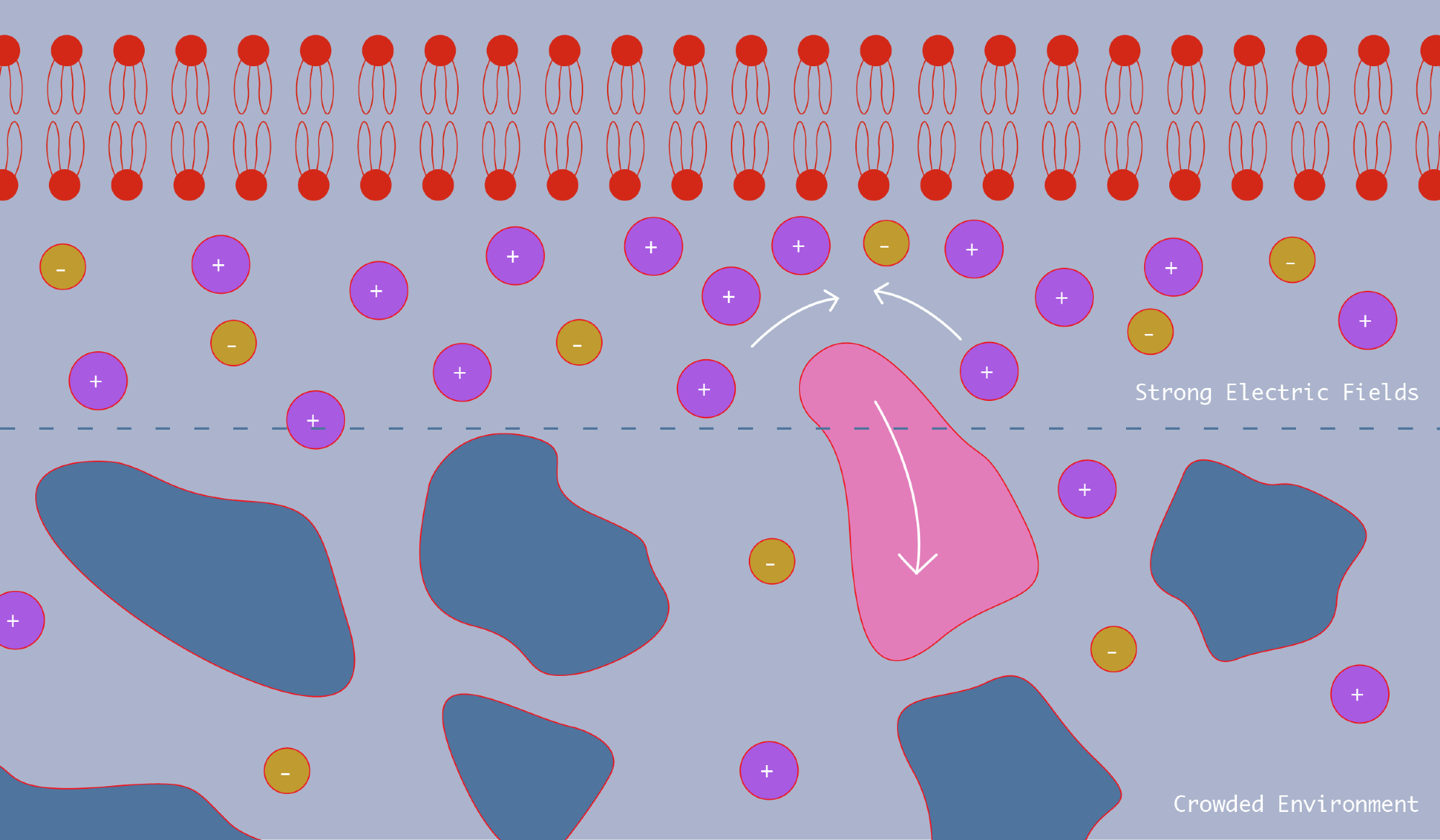A group of researchers led by experts at the National Institute of Standards and Technology (NIST) has explained why the membranes that encapsulate the cells possess the ability to repel approaching nanoscale molecules. Their findings could have implications for the development of several cell-targeting drug treatments.
 Cell membranes generate powerful electric field gradients that are largely responsible for repelling nano-sized particles like proteins from the surface of the cell — a repulsion that notably affects uncharged nanoparticles. In this schematic drawing, a negatively charged membrane (at top, in red) attracts small, positively charged molecules (purple circles), which crowd the membrane and push away a far larger, neutral nanoparticle (pink). Image Credit: N. Hanacek/NIST
Cell membranes generate powerful electric field gradients that are largely responsible for repelling nano-sized particles like proteins from the surface of the cell — a repulsion that notably affects uncharged nanoparticles. In this schematic drawing, a negatively charged membrane (at top, in red) attracts small, positively charged molecules (purple circles), which crowd the membrane and push away a far larger, neutral nanoparticle (pink). Image Credit: N. Hanacek/NIST
The team’s results, which are published in the Journal of the American Chemical Society, demonstrate that the primary mechanism preventing nanoscale particles from adhering to the cell surface is the strong electrical fields produced by cell membranes. Neutral, uncharged nanoparticles are particularly affected by this repulsion, partly because the electric field draws smaller, charged molecules that jam the membrane and push larger particles away.
The repulsion can contribute to the efficacy of pharmaceutical therapies, as many are based on proteins and other nanoscale particles that target the membrane.
The results offer the first concrete proof that the repulsion is caused by the electric fields. David Hoogerheide of NIST believes that further research should be done on the effect by scientists.
This repulsion, along with the related crowding that the smaller molecules exert, is likely to play a significant role in how molecules with a weak charge interact with biological membranes and other charged surfaces. This has implications for drug design and delivery, and for the behavior of particles in crowded environments at the nanometer scale.
David Hoogerheide, Study Author, NIST Center for Neutron Research
Membranes define boundaries in almost all cell types. A cell has many membranes that constitute components of organelles like the mitochondria and the Golgi apparatus, in addition to its outer membrane that encloses and shields the inside.
Medical research benefits greatly from understanding membranes, in part because drugs frequently target proteins embedded in cell membranes. Certain membrane proteins function as gates to control what enters and leaves the cell.
There might be activity in the region close to these membranes. The cell membrane and thousands of various sorts of molecules are crowded together, and as anybody who has attempted to get through a crowd knows, it can be difficult. Larger molecules, like proteins, have restricted mobility, whereas smaller molecules, like salts, can squeeze into narrower spaces and move more easily.
Since molecular crowding affects how cells operate in the real world, Hoogerheide added, it has become a very busy area of scientific inquiry. The careful interaction of the components in this cellular “soup” determines how a cell functions. It now seems that the cell membrane could also be involved, as it sorts molecules close to it according to charge and size.
“How does crowding affect the cell and its behavior? How, for example, do molecules in this soup get sorted inside the cell, making some of them available for biological functions, but not others? The effect of the membrane could make a difference,” Hoogerheide added.
Scientists have given little attention to this effect at the nanoscale since it requires extremely powerful fields to move nanoparticles, despite the fact that researchers frequently employ electric fields to move and separate molecules (a method known as dielectrophoresis). But the only thing that an electrically charged membrane produces is strong fields.
Hoogerheide further added, “The electric field right near a membrane in a salty solution like our bodies produce can be astoundingly strong. Its strength falls off rapidly with distance, creating large field gradients that we figured might repel nearby particles. So, we used neutron beams to look into it.”
The scientists devised tests to investigate the impact of a membrane on nearby molecules of PEG, a polymer that generates chargeless nanoparticles, and how neutrons can differentiate between various hydrogen isotopes.
Since hydrogen makes up a large portion of PEG, the researchers were able to determine how near the PEG particles were to the membrane by immersing the membrane and PEG in a solution of heavy water, which is created with deuterium rather than hydrogen atoms found in regular water. They used instruments at Oak Ridge National Laboratory as well as a method known as neutron reflectometry at the NCNR.
The studies, together with molecular dynamics simulations, gave the first evidence that the membranes’ significant field gradients were responsible for the repulsion: PEG molecules were significantly more repelled from charged surfaces than from neutral surfaces.
While the discoveries do not reveal any fundamentally new physics, Hoogerheide believes they do exhibit well-known physics in an unusual setting, which should pique scientists’ interest — and prompt additional investigation.
Hoogerheide concluded, “We need to add this to our understanding of how things interact at the nanoscale. We have demonstrated the strength and significance of this interaction. Now we need to investigate how it affects these crowded environments where so much biology happens.”
Journal Reference:
Aguilella-Arzo, M., et. al. (2024) Charged Biological Membranes Repel Large Neutral Molecules by Surface Dielectrophoresis and Counterion Pressure. Journal of the American Chemical Society. doi:10.1021/jacs.3c12348